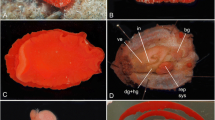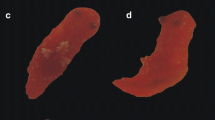Abstract
During recent cruises aboard RV Polarstern in the Antarctic Peninsula region, a new species of benthic octopodid was discovered whose generic affinities based on morphological characteristics were uncertain. Molecular sequence analysis of six mitochondrial and nuclear genes allows this species to be placed with confidence within the genus Pareledone. The species is described herein and morphological diagnostic characters are provided for its identification.






Similar content being viewed by others
References
Allcock AL (2005) On the confusion surrounding Pareledone charcoti (Joubin 1905) (Cephalopoda: Octopodidae): endemic radiation in the Southern Ocean. Zool J Linn Soc 143:75-108
Allcock AL, Hochberg FG, Rodhouse PGK, Thorpe JP (2003a) Adelieledone, a new genus of octopodid from the Southern Ocean. Antarct Sci 15:415-424
Allcock AL, Hochberg FG, Stranks TN (2003b) Re-evaluation of Graneledone setebos (Cephalopoda: Octopodidae) and placement in the genus Megaleledone. J Mar Biol Ass UK 83:319-328
Allcock AL, Collins MA, Piatkowski U, Vecchione M (2004) Thaumeledone and other deep water octopodids from the Southern Ocean. Deep Sea Res II 51:1883-1901
Arntz WE, Brey T (eds) (2001) The expedition ANTARKTIS XVII/3 (EASIZ III) of RV “Polarstern” in 2000. Ber Polar Meeresforsch (Rep Polar Mar Res) 402:1–181
Carlini DB, Young RE, Vecchione M (2001) A molecular phylogeny of the Octopoda (Mollusca: Cephalopoda) evaluated in light of morphological evidence. Mol Phylogenet Evol 21:388–397
Folmer O, Black M, Hoeh W, Lutz R, Vrijenhoek R (1994) DNA primers for amplification of mitochondrial cytochrome c oxidase subunit from diverse metazoan invertebrates. Mol Mar Biol Biotech 3:294–299
Fütterer DK, Brandt A, Poore GCB (eds) (2003) The expeditions ANTARKTIS-XIX/3-4 of the research vessel POLARSTERN in 2002. Ber Polar Meeresforsch (Rep Polar Mar Res) 470:1–174
Guizk MT, Norman MD, Crozier RH (2005) Molecular phylogeny of the benthic shallow-water octopuses (Cephalopoda: Octopodinae). Mol Phylogenet Evol 37:235–248
Kattner G (ed) (1998) The expedition ANTARKTIS XIV/2 of RV “Polarstern” in 1996/97. Ber Polarforsch (Rep Polar Res) 274:1–87
Lu CC, Stranks TN (1994) Synopsis of Pareledone & Megaleledone species, with description of two new species from East Antarctica (Cephalopoda: Octopodidae). Mem Natl Mus Vic 54:221–242
Piatkowski U, Allcock L, Hevia M, Steimer S, Vecchione M (1998) Cephalopod ecology. In: Kattner g (ed) The expedition ANTARKTIS XIV/2 of RV “Polarstern” in 1996/1997. Ber Polarforsch (Rep Polar Res) 274:41–47
Piatkowski U, Allcock L, Vecchione M (2003) Cephalopod diversity and ecology. In: Fütterer DK, Brandt A, Poore GCB (eds) The expeditions ANTARKTIS-XIX/3-4 of the research vessel POLARSTERN in 2002. Ber Polar Meeresforsch (Rep Polar Mar Res) 470:32–38
Rambaut A (2002) Se-Al v2.0a11 carbon. Oxford University, Oxford
Rambaut A, Drummond AJ (2003) Tracer. 1.0.1. Oxford University, Oxford
Ronquist F, Huelsenbeck JP (2003) MrBayes3: Bayesian phylogenetic inference under mixed models. Bioinformatics 19:1572–1574
Roper CFE, Voss GL (1983) Guidelines for taxonomic descriptions of cephalopod species. Mem Natl Mus Vic 44:13–27
Saitou N, Nei M (1987) The neighbor-joining method: a new method for reconstructing phylogenetic trees. Mol Biol Evol 4:406–425
Simon C, Pääbo S, Kocher T, Wilson AC (1990) Evolution of the mitochondrial ribosomal RNA in insects as shown by the polymerase chain reaction. In: Clegg M, O’Brian S (eds) Molecular evolution, UCLA symposia on molecular and cellular biology, new series, vol 122. Alan R. Liss Inc., New York, pp 142–180
Simon C, Franke A, Martin AP (1991) The polymerase chain reaction: DNA extraction and amplification. In: Hewitt GM, Johnston AWB, Young JPW (eds) Molecular techniques in taxonomy. NATO Advanced Studies Institute, H57. Springer, Berlin, pp 329–355
Simon C, Frati F, Beckenback A, Crespi B, Liu H, Flook P (1994) Evolution, weighting and phylogenetic utility of mitochondrial gene sequences and a compilation of conserved PCR primers. Ann Entomol Soc Am 87:651–701
Strugnell JM, Norman MD, Drummond AJ, Cooper A (2004) The octopuses that never came back to earth: neotenous origins for pelagic octopuses. Curr Biol 18:R300–R301
Swofford DL (1998) PAUP*4.0—Phylogenetic analysis using parsimony (*and other methods). Sinauer Assosiates Inc. Publishers, Sunderland
Taggart JB, Hynes RA, Prodöhl PA, Ferguson A (1992) A simplified protocol for routine total DNA isolation from salmonid fishes. J Fish Biol 40:963–965
Vecchione M, Allcock L, Piatkowski U (2005) Unusual incirrate octopods from the South Shetland Islands, Antarctica, including Bathypurpurata profunda, a newly discovered genus and species of deepwater pygmy octopod (Cephalopoda). Phuket Mar Biol Centre Res Bull 66:109–115
Acknowledgments
We would like to thank the Alfred Wegener Institute for extensive sea time aboard RV Polarstern. Many thanks to Iain Barratt for information on egg counts in Adelieledone and P. turqueti. JS is supported by a Natural Environment Research Council Antarctic Funding Initiative grant (NE/C506321/1) awarded to LA.
Author information
Authors and Affiliations
Corresponding author
Rights and permissions
About this article
Cite this article
Allcock, A.L., Strugnell, J.M., Prodöhl, P. et al. A new species of Pareledone (Cephalopoda: Octopodidae) from Antarctic Peninsula Waters. Polar Biol 30, 883–893 (2007). https://doi.org/10.1007/s00300-006-0248-9
Received:
Revised:
Accepted:
Published:
Issue Date:
DOI: https://doi.org/10.1007/s00300-006-0248-9




